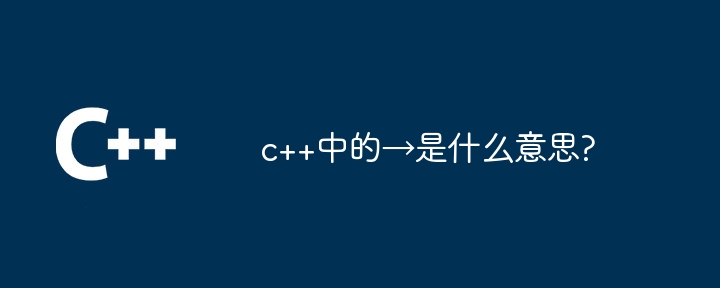
In C, the "→" operator (member access operator) is used to access members of a class, including: Data member access: Returns a reference to a data member. Member function call: Returns a function pointer pointing to the member function. The "→" operator only works on pointers to instances of classes, for value types the . operator should be used.

The “→” operator in C
In C, the “→” operator is called "Member access operator", which is used to access class members. Specifically, it is used to access data members and member functions in a class.
Grammar
The syntax of the "→" operator is:
<code class="cpp">objectPtr->member</code>
Among them:
is a pointer to an instance of the class.
is a data member or member function in a class.
Usage: Data member access
When the "→" operator is used to access a data member, it returns a reference to the data member. The following example shows how to access thename data member of a class:
<code class="cpp">class Person {
public:
string name;
};
int main() {
Person person;
person.name = "John Doe";
string& name = person->name;
cout << name << endl; // 输出:"John Doe"
}</code>Usage: Member function call
When the "→" operator is used When a member function is called, it returns a function pointer. The following example shows how to call thegetName member function of a class:
<code class="cpp">class Person {
public:
string getName() { return name; }
string name;
};
int main() {
Person person;
person.name = "John Doe";
string (*getName)(Person*) = person->getName;
string name = getName(&person);
cout << name << endl; // 输出:"John Doe"
}</code>Note
operator can be used.
operators.
The above is the detailed content of What does → mean in c++?. For more information, please follow other related articles on the PHP Chinese website!
 What are the differences between c++ and c language
What are the differences between c++ and c language
 Recommended learning order for c++ and python
Recommended learning order for c++ and python
 Cost-effectiveness analysis of learning python and c++
Cost-effectiveness analysis of learning python and c++
 Is c language the same as c++?
Is c language the same as c++?
 Which is better to learn first, c language or c++?
Which is better to learn first, c language or c++?
 The difference and connection between c language and c++
The difference and connection between c language and c++
 C++ software Chinese change tutorial
C++ software Chinese change tutorial
 Cost-effectiveness analysis of learning python, java and c++
Cost-effectiveness analysis of learning python, java and c++




